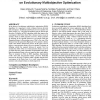TEC
2010
14 years 2 months ago
2010
Abstract--Assuming that evolutionary multiobjective optimization (EMO) mainly deals with set problems, one can identify three core questions in this area of research: (i) how to fo...
EUSFLAT
2009
14 years 5 months ago
2009
One of the new trends in genetic fuzzy systems (GFS) is the use of evolutionary multiobjective optimization (EMO) algorithms. This is because EMO algorithms can easily handle two c...
ACMSE
2008
ACM
14 years 9 months ago
2008
ACM
In previous work, a neural network was used to increase the number of solutions found by an evolutionary multiobjective optimization algorithm. In this paper, various approaches a...
EMO
2006
Springer
14 years 11 months ago
2006
Springer
Recent works in evolutionary multiobjective optimization suggest to shift the focus from solely evaluating optimization success in the objective space to also taking the decision s...
GECCO
2004
Springer
2004
Springer
Using Clustering Techniques to Improve the Performance of a Multi-objective Particle Swarm Optimizer
15 years 22 days ago
In this paper, we present an extension of the heuristic called “particle swarm optimization” (PSO) that is able to deal with multiobjective optimization problems. Our approach ...
GECCO
2005
Springer
15 years 26 days ago
2005
Springer
We focus on the handling of overlapping solutions in evolutionary multiobjective optimization (EMO) algorithms. First we show that there exist a large number of overlapping soluti...
EMO
2005
Springer
15 years 26 days ago
2005
Springer
Abstract. Evolutionary algorithms have been quite effective in dealing with single-objective “optimization” while the area of Evolutionary Multiobjective Optimization (EMOO) h...
EMO
2005
Springer
15 years 26 days ago
2005
Springer
Abstract. The hypervolume measure is one of the most frequently applied measures for comparing the results of evolutionary multiobjective optimization algorithms (EMOA). The idea t...
GECCO
2007
Springer
15 years 1 months ago
2007
Springer
In the design of evolutionary multiobjective optimization (EMO) algorithms, it is important to strike a balance between diversity and convergence. Traditional mask-based crossover...
GECCO
2007
Springer
15 years 1 months ago
2007
Springer
A new evolutionary technique for multicriteria optimization called Guiding Hyper-plane Evolutionary Algorithm (GHEA) is proposed. The originality of the approach consists in the f...


